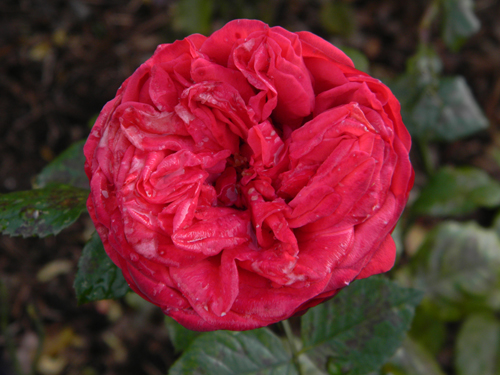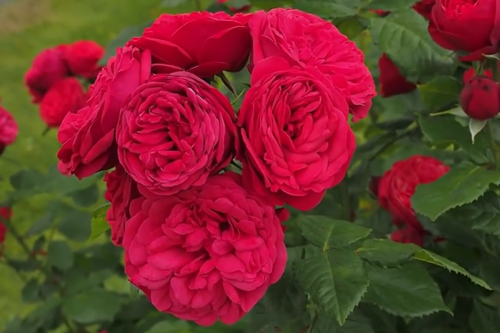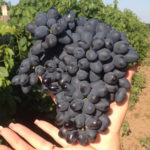Rose Red piano
If you like peonies, but want something more graceful and sophisticated, get roses belonging to the peony group. They are named so because of the special shape of the inflorescences. Meet the brightest representative of this noble plant category: Red Piano.

History of appearance
This, without exaggeration, an amazing variety was created in Germany in 2007. Bred by her breeder Christian Evers. In the year of its appearance, the variety was presented by the well-known floriculture company Rosen-Tantau. In catalogs and other information sources, you can also find it under the names Tan01360, Hope and Glory, Mistinguett.
Description of appearance and features
Red piano is a tea hybrid of small height (100, maximum 120 cm), growing by about the same width. Because of this, it looks like a neat ball covered in dense, dark green foliage with a glossy sheen. The shoots of the decorative perennial are long and erect.
Flowers of a varietal plant are very beautiful. In the bud stage, they look like dense miniature balls, and when they open, they take the shape of a bowl and show the features of old English roses. Their central part is densely packed with numerous petals, the number of which in one flower reaches hundreds. For this reason, the middle of the bud is not visible even in the phase of complete dissolution. The flowers of this variety are large (8-11 cm in diameter), terry and are collected in clusters of 3, 5, or even 8 pieces. Their delicate, sweet aroma is reminiscent of ripe raspberries. But the most important thing about Red Piano flowers is the hue. It is characterized as a deep red, but they shimmer and seem to glow from the inside. The flowering shrub is usually quite lush and abundant. Inflorescences appear on it throughout the growing season until late autumn without interruption.
Our heroine is a winter-hardy culture (even tolerates severe frosts), endowed with good immunity to various kinds of diseases, including powdery mildew and black spot. Its luxurious flowers do not fade under the rays of the bright summer sun, do not lose their attractiveness and shape in rainy weather. The rose may need tying and support at peak flowering.

Growing and care
For this variety, the degree of illumination of the site plays an important role. The culture should be exposed to sunlight - better than bright, diffused light - for most of the day. This is necessary to ensure the full development and growth of ornamental shrubs, as well as for abundant flowering. The plant should be protected from cold drafts and gusty winds, for which the perennial is not planted in the most open spaces.
Red piano prefers a nutritious, loose, drained soil with a slightly acidic reaction. In order for the soil to meet all of the listed conditions, it is required to add humus, sand and peat to it. The soil for planting a rose can be used with the most common, however, if possible, choose loam for the set goal. Keep in mind that heavy, over-compacted and too wet soils will adversely affect the Red Piano's health.
Before planting an ornamental flowering shrub on the site, dig a hole up to half a meter deep and at least 100 cm wide.This should be done due to the significant size of the plant's root system, which it will reach in the future as it grows. At the bottom of the hole, lay a layer of drainage (gravel, perlite), then a layer of earth, fertilizers and new soil mixture. Now place the seedling in the hole and cover the roots with the remaining substrate. In conclusion, pour the bush with settled water, and then mulch the area of the near-trunk circle with humus or sawdust.
Watering the rose is necessary as the topsoil dries up. Complete drying out of the earthen coma under the flower is unacceptable. However, the gulf of soil will not lead to anything good: the roots of the perennial will simply begin to rot. After each moistening of the soil, loosening is necessary, but this procedure must be performed only after a day.
Top dressing is carried out according to the following scheme: at the beginning of the period of active growth, that is, in the spring, nitrogen is applied under the flower (preferably as part of an organic fertilizer), with the arrival of summer - mineral concentrates rich in calcium and phosphorus, in September - potash fertilizer. You must be very careful with this event: too frequent top dressing will cause the foliage to be dumped by the shrubs, and the deficiency in the soil under the culture of nutrients will not allow the rose to bloom.
Despite the fact that the Red Piano variety has a high resistance to fungal and bacterial diseases, in order to prevent it, it should be periodically sprayed with copper sulfate, as well as Epin to increase the already excellent natural immunity to such troubles. Our heroine is extremely rarely affected by insect pests, but still know: under unfavorable conditions or lack of proper care, aphids, spider mites and leafworm caterpillars may appear on the plant. They are fought with by treating the culture with an insecticide solution.
The rose bush needs regular pruning. In the spring, dry, diseased and extremely weak branches are removed from it, in the summer - those shoots that are knocked out of the total volume of the plant and thereby spoil its shape. In the fall, without exception, the stems are shortened, and the bush itself is spud with dry earth. During the summer, it is important to remove faded buds in a timely manner. Shelter will only be needed for those plants that are cultivated in areas with harsh climatic conditions. They will serve as a cap made of polystyrene or spruce branches. It is better not to use plastic wrap as insulation, otherwise there is a risk of plant damping out.
Use cases
Spectacular tea hybrid Red piano looks great against the background of a bright green lawn, in the foreground of the site. These options can be used if you want to focus on this particular plant in the flower garden. But Red Piano is also suitable for decorating borders on the sides of garden paths, low hedges, for dividing the territory into zones. She looks great in a classic flower bed, in mixborders and rabatkas. In group plantings, the culture is combined with roses that have buds of close or contrasting shades, as well as with clematis, phlox, lilies, verbena, cosmea, fragrant levkoy, veronica, digitalis, delphinium. Combinations of the German beauty with conifers are good: juniper, spruce, thuja, boxwood. The variety is ideal for cutting.








